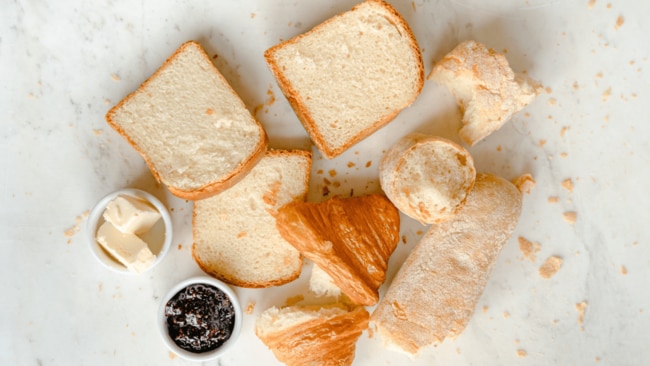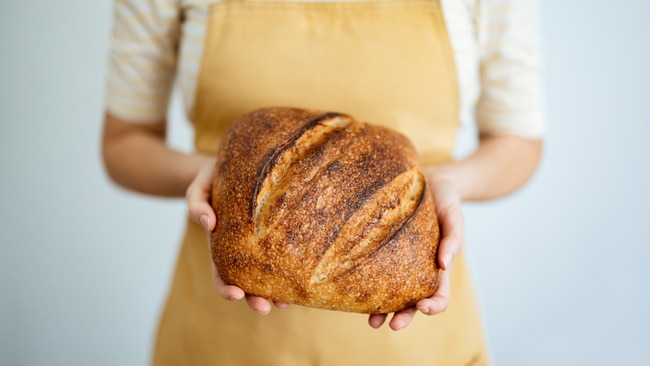Is white bread really that bad for you? A dietitian weighs in
It depends on the slice

Lifestyle
Don't miss out on the headlines from Lifestyle. Followed categories will be added to My News.
While it's a staple in most of our diets, not all loaves of bread are created equal. Here's what you need to know about what's in white bread - and how much of it is healthy to eat.
For any of us who remember growing up with fresh, soft white bread sandwiches it may seem slightly ridiculous to suggest that white bread is not healthy?
How could a food as simple as bread be bad for you?
So, if you would rather eat no bread at all rather than swap to anything brown or grainy, here are some of the reasons why you probably won't see white bread in the supermarket trolley of most nutritionists.
Like what you see? Sign up to our bodyandsoul.com.au newsletter for more stories like this.
How is white bread made?
White bread has a base of refined white flour, in which wholegrains have been processed so both the bran and germ components of the grain are removed. This creates a quickly digested carbohydrate that is easy to consume.
The downside of the soft, sweet, white loaf is that the significant processing also removes much of the dietary fibre and key nutrients found naturally in wholegrains including Vitamin B, Vitamin E, zinc and magnesium.
This is one of the reasons that you now see ‘high fibre’ white bread varieties heavily marketed in supermarkets, they are basically replacing some of the dietary fibre that is found in wholegrain and wholemeal bread varieties.
Why is white bread not the best choice nutritionally?
White bread has a relatively high glycaemic index, which means that it results in rapid increases in blood glucose levels after eating. While this can be helpful if you are an athlete who needs assess to quickly digested fuel, for the rest of us, fluctuating blood glucose levels are not ideal for cell health.
Not only does it result in significant hormonal fluctuations, leaving us more prone to dysregulated hunger and appetite, but over time high glucose levels are damaging to the cells, especially for those who are at risk of developing Type 2 diabetes.
As bread is a dietary staple that we tend to eat regularly, high GI white bread is likely to be negatively impacting glucose levels over time.

The issue with white bread
If you think about the types of bread we are most likely to find when we pick up food away from home – whether it is with your eggs on toast, a wrap at lunchtime or the bread served at restaurants, it is largely white bread, and typically large slices and portions.
Nutritionally this means that many of us are routinely consuming high GI, white bread, in large portions, which ultimately will be impacting our blood glucose control and the health of the body’s cells.
It is the relatively frequent consumption of large portions of refined white flour that is a concern from a health perspective.
What about low-GI white bread?
While there is a growing range of low-GI and high-fibre white bread options, they are still highly processed and lack the nutrient density that wholemeal, and to a greater extent wholegrain bread has.
So yes, they are a better option than plain white bread, but still not the best choice nutritionally when it comes to bread.

So is sourdough bread better?
It depends. There is a wide range of different types of sourdough, some of which are subjected to a long fermentation process, which helps to lower the glycaemic index of the bread, making it a better choice nutritionally than white, sliced bread.
On the other hand, the quality of sourdough differs widely, and some brands may simply have sourdough added to the ingredient list.
The other less frequently mentioned issue is that the slices of sourdough are typically large, which means they have a relatively high carbohydrate load or can contain double the amount of carbohydrate as a typical slice of small, grain bread and as such easily overconsumed.
The take-home message
Is white bread as bad as lollies or soft drinks? Well, no but it is certainly not that much better, plus chances are you eat it a lot more frequently than sugary treats.
If you are serious about your health, and you can tolerate it, dense grainy bread is the way to go.
Originally published as Is white bread really that bad for you? A dietitian weighs in



